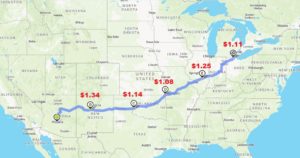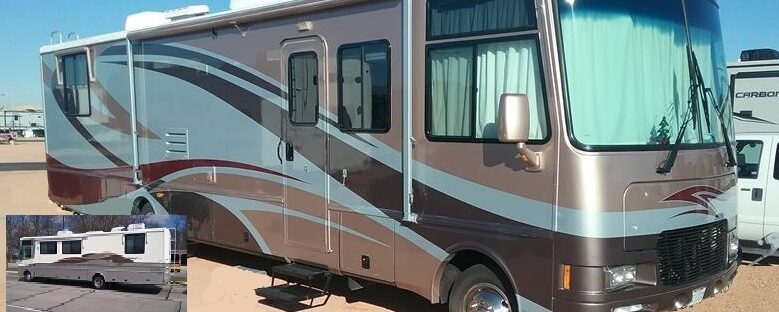We’re finally back home in Ohio after spending the winter in Arizona. On these trips, I normally run at 62-65 MPH and stop about every three hours. While stopped, I usually top off the tank, about 25 -30 gallons per stop. The one way trip usually takes 4-5 days to cover 2,000 to 2,200 miles, depending on the route we take.
This years return trip was unusual because of the COVID19 and the government shutdowns. I decided to hit the road hard and get back as soon as possible, 2 1/2 days. We’d take the shortest route, 2,000 miles, minimize contact with other people, and run at or slightly above the legal speed limits. In the western part of the trip, this was 75-77 MPH.
The biggest change I made was pre-planning my fuel stops to take advantage of the lowest fuel prices and maximum distance I could travel on a tank of gas. Planning for 6.5 MPG and a 72 gallon gas tank would give me a range of about 470 miles. With this piece of data, I set my fueling distance at around 400 miles.
I used the Pilot/Flying J web site to find all gas stations along the route that had RV fueling lanes and recorded the fuel cost for each one. I then looked through this data and found the lowest fuel price that was between 300 and 500 miles apart. Coincidentally, with the exception of the first stop, the lowest priced fuel stops were just about 400 miles apart. I also noted in many instances, fuel prices varied 50 to 75 cents a gallon in as little as 50 miles.

Our first scheduled fuel stop (Albuquerque, NM) was about 470 miles from Phoenix, AZ, so to make sure I wouldn’t run out of gas, I added 7 gallons when we stopped for a short break in Winslow, AZ. The total fuel burn between Phoenix and Albuquerque was 65 gallons. So I could have made it, but this was just a little to close for comfort.
The remainder of the fuel stops took under 60 gallons per stop, All stops were the lowest price within 200 miles that had RV fueling lanes.
SUMMARY
This was the first time with this fueling strategy. I figured I saved approximately $150 in fuel cost (50 cents per gallon) for one way trip. The only downside would be, during portions of the trip, I may not be able to run the generator because of low fuel level. Something to think about when traveling in the winter.
There were no problems running 75 MPH with an occasional 80 MPH on a long downhill. Curiously, I seen a slight increase in MPG when comparing the 2400 mile western trip to AZ to the eastern trip back to Ohio. 6.78 mpg westbound, 6.91 mpg eastbound. The only explanation I can offer is that westbound has more headwind and eastbound has more tailwind.

Really enjoy reading your stuff on here. Thanks,
I run mine at 67 to 70 mph. I call it the sweet spot. When I hit a hill at 67mph it normal does not down shift. But when I’m chugging along at 65 it will down shift on most small hill by the time I get to the top.
By the way I use use Lukus Oil treatment and have 3 modifications to the engine. Headers k&n air filter and set of 45psi injectors from the Injector Clinic. I get on average 10 to 13 mpg.
Daniel, what are you driving that gets that kind of mileage?
Hi,
I am considering buying a 99 Southwind 35S. It has 27k miles.
Do you have any red flags I should look for, or/and any suggestions to look for during my test drive tomorrow?
Thanks,
Stacey
If its on an F53 chassis, use this checklist for the chassis portion only:
https://www.1999southwind.com/f53-inspection-maintenance-checklist/
A more generic checklist that covers all the motorhome is here:
https://www.1999southwind.com/DOWNLOAD/PrePurchase_Mar_17.doc
I really enjoyed reading about all of the TSB’s you performed on your coach. I have a 1999 Pace Arrow Vision on a 208 F53 Ford. I am the second owner of this coach and none of the TSB’s were completed except the safety TSB on the cruise control. Last winter I followed your list and started knocking off these TSB’s The PCM fix was the hardest because of the close quarters under the steering column. My question to you is after I completed the ground wire redo it fixed the starting up in 2 or 3 gear however now I seem to have a OBDII code P0102 that will not go away I keep resetting it. I have replace the MAF sensor and the air cleaner and also noticed the transmission is shifting harder going into 3rd and 4th gear. It has a banks trans command but I have put the bypass plug in it and no change. Any suggestions? My wife and I love this coach and have logged over 40k miles on it and starting early next year we are planning on several long distance trips. Thanks you for all the tips Mike.
Seems like it might be related to the TSB. I’d look at the PCM connector and make sure a pin didn’t get pushed out or bent.
Inspect the intake tubes for leaks. Possibly look at the raw data using your Torque app.
We have a 1999 foot Fleetwood Southwind. It has over 113,000 miles on it. We had it painted 3 years ago. Still looks good and runs well. Has made 5 trips to Alaska and back.We live in Mesa for most of the year do have relatives in Cleveland and Buffalo so we have made that trip you wrote about.Crosswinds acrossOK and KS sure kill the gas millage. Enjoyed the information you shared abiout the starter issue. Having the problem
Thanks. The worst I ever seen was a west bound trip a couple years ago, driving into a 40 mph headwind. For most of that leg the OD was off and I had the gas pedal on the floor. I think I got around 4 mpg. You could hear the gasoline being sucked out of the tank. 🙂
Really enjoy your content here. I have a 2000 Southwind 32V, the poor engine power while hauling a MDX makes me want to look for a diesel pusher. Have you thought about changing your rig to a diesel?
Before we bought our Southwind, I had a 2001 Mirada with the same F53 chassis. When we were ready to upgrade to something larger, we initially looked at DPs, not for power, but for build quality. However, when we looked at this SW, the build quality was that of a DP.
I’m very familiar with the F53 but knew nothing about the Freightliner. The purchase price and maintenance cost associated with the DP were significantly higher than the F53, and the learning curve would be very steep. To me, what I would gain was not worth the additional expense.
I pull a 3,000 lb Saturn Vue or Toyota Camry. I wouldn’t characterize it as a “struggle”, I do long, high altitude, uphill pulls with a different strategy than I do in my car. I slow down, downshift, and keep the rpms up there so I have power available. To date, I never meet a hill I couldn’t climb, I just do it at a slower speed.
I am planning a trip from Utah to South Carolina. Is there any apps that are designed towards Motorhomes in planning the route? (Like avoiding mountain passes or really strong wind or adverse weather) Plus considering your mpg or gas capacity in the travel??
Thanks again!!